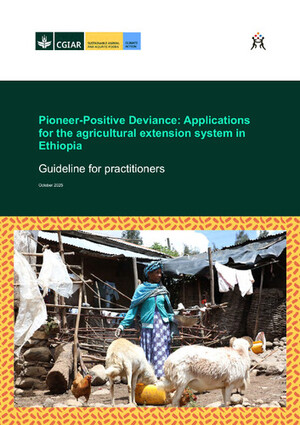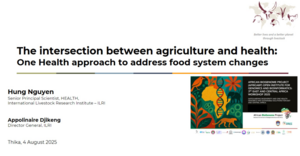
Global diagnosis – one health approach necessary
The acclaimed Indian novelist Arundhati Roy has written that the ongoing tragedy of COVID-19 is a sort of global X-ray, exposing the weak or broken elements under the surface of the world’s economic and health systems. One of those elements, arguably, is a failure to bring enough financial and institutional resources to bear on One Health programs, which bring multiple disciplines together to attain optimal health for people, animals and the environment.
As a leading livestock for development research organization based in the developing world, the International Livestock Research Institute (ILRI) has been engaged in One Health research almost since a version of the term was first coined, some two decades ago. (The original, lengthier term, inevitably shortened over time, was ‘One Health, One World’.) For more on ILRI’s One Health work, see here.
Unfortunately, as ILRI Director General Jimmy Smith has written, ‘There has long been an intellectual consensus on the benefits of a One Health approach, but that consensus never led to a corresponding institutional response.’
At a recent online town hall with staff, several ILRI’s scientists provided an overview of the One Health approach and explained why the current crisis is a stark reminder of the perils of neglecting it. They also provided an overview of the current crisis. The meeting was moderated by Ekta Patel, a bioscience communications manager at ILRI.
Eric Fèvre, a joint appointee at ILRI and professor of veterinary infectious diseases at the University of Liverpool, and a Member of Lancet One Health Commission, opened the presentation by providing an overview of some of the terms in current use.
An endemic disease, he said, is a disease found among a particular group of people or animals in a particular geographical area, in a stable fashion. The term comes from the Greek word endemos, which means native. Examples might be malaria in sub-Saharan Africa, or echinococcus in Turkana, Kenya. An epidemic, by contrast, is somewhat more unstable than an endemic disease. An example might be the current African Swine fever in China. Finally, he said, there is the term pandemic, which is simply an epidemic but at a much bigger scale. It comes from the Greek pandemos which means belonging to all the people: ‘And really a pandemic is an epidemic that’s occurring worldwide or over a very large area, crossing international boundaries and affecting a very substantial population.’
Patel asked Fèvre what we need to do to prevent future pandemics. ‘First of all, we need surveillance’, he said, ‘a lot of surveillance.’ And in the context of One Health, Fèvre said, ‘that means doing surveillance at interfaces between animals and people, both wild animals and domestic animals, and also accounting for the environmental envelope in which transmission has occurred.’ More than that, he said, we need to address the many root causes of transmission, such as people’s encroachment into new environments, or poor management of complex interfaces, such as forests or cities. ‘It’s really about managing the way that we interact with the natural world,’ he said.
Delia Randolph, an epidemiologist and veterinarian at ILRI, took questions about what One Health is and why that approach has become so central during the present pandemic. One Health, she said, involves the integration of three health systems that are often considered separately: human health, animal health and ecosystem health. ‘I emphasize integration’, said Randolph, ‘because I think we’re all used to working in our own discipline, perhaps on the same project, but in our own silo, side by side.’ Another essential component, she said, is work at the intersection of the three healths. ‘ A third aspect is collaboration and adding value from collaboration. ‘One Health requires not just working across health disciplines’, she said, ‘but also working across other disciplines such as environment, ecology, gender, socioeconomics.’
Randolph concluded by referencing an issue that has become increasingly salient, and that may entail different cost-benefit analyses in developing countries. ‘My concern, especially in Kenya and other low-and middle-income countries, is that the impacts of attempting to control this truly serious pandemic can in themselves have serious impacts, in terms of people’s access to food, to work, to livelihoods.’ The question, said Randolph, is whether we can manage that trade-off to bring [COVID-19] under control without causing too much damage to livelihoods and economies.’
Bernard Bett, a veterinarian at ILRI, reviewed some of the work ILRI is doing in One Health. ‘We have a large portfolio of research we do on One Health,’ said Bett. ‘We are working on emerging and zoonotic infectious diseases, under Eric’s direction. We’re looking at transmission patterns of diseases between livestock, humans and wildlife, and we’re building partnerships between the veterinary community, the human health community, and the environment community.’
‘We’re also trying to look at how land use change and environmental change enhances or precipitates disease occurrences. Irrigation, for example, is an intensive form of agriculture that helps to develop mosquitoes, and so transmit vector-borne diseases,’ said Bett.
Kristina Röesel, an animal and human health scientist at ILRI, spoke about efforts to consolidate ILRI’s One Health work under a unified institutional umbrella, and the plans to map One Health initiatives across sub-Saharan Africa. Just before COVID-19 took off in China, the German government allocated 8 million Euros for a period of five years to build up a One Health Centre at ILRI. The purpose of the centre, said Roesel, is not to reinvent the wheel: ‘It’s more about consolidating all these One Health efforts that we have already included in our research at ILRI over the past two decades or so. Finally, she said, it will be about attempting to scale activities, for example by training frontline One Health practitioners in various developing countries or reaching out to policymakers through better science communication.
Arshnee Moodley, CGIAR Antimicrobial Resistance (AMR) Hub leader explained how the same antimicrobials are used in humans, livestock, aquaculture and in our pets and crops. She explained that the AMR that arises in these niches are shared either by direct contact or via a common environment, Therefore, she argued, we need to take a multisectoral approach to ultimately reduce AMR in humans. She also highlighted the importance of producing data on agricultural AMR risks in low- and middle-income countries, which is currently rather limited.
Hung Nguyen, ILRI’s regional representative for East and Southeast Asia, explained that ILRI’s One Health programs in Southeast Asia focus on two areas: ‘One is more research. And the second one, I would say, is capacity and policy translation.’ In the former, he said, they are focused on mapping zoonotic disease and infectious disease and on working with various neglected diseases such as rabies and dengue. They have also done a lot of work on food safety. On the latter, they have worked on building up some of the EcoHealth or One Health resource centres in Thailand, Vietnam and Indonesia and building up a local policy task force, which focuses mainly on food safety.
Iain Wright, deputy director general research and development–integrated sciences at ILRI, believes that there are opportunities to build One Health programs not only within ILRI but also throughout the developing world: ‘I have a big vision for a truly One Health centre, serving low- and middle-income countries that really bring these communities together, a multi-institutional, multinational organization,’ he said. ‘
Dieter Schillinger, deputy director general of research and development–biosciences, emphasized the importance of developing an interdisciplinary approach: ‘We have to keep in mind there more than 800,000 mammalian and bird viruses around that pose a potential risk to humans. That means pandemics come and go, but they will come in a higher frequency than in the past. That means we need to address health crises through a holistic approach that includes human, health and veterinary medicine, but also environmental and social science.’
‘We have to improve our vaccine technologies, he said, but we also have to intensify our current surveillance activities—because ‘surveillance is one of the most important aspects of public health systems,’ he added
Smith concluded the town hall by noting that earlier in his career he had led the World Bank’s work on avian influenza. ‘At that time, we realized early on that the way to control pandemics was to have a One Health approach,’ he said. ‘We did a lot of calculations about cost benefits, and we figured that with investments of USD17 billion a year, we would produce returns of over USD100 billion.’
Unfortunately, after fears of the avian influenza had passed, there was no real impetus to implement the program. ‘Now we have an opportunity to revisit the importance of these efforts,’ he said. The world may finally be coming around to seeing the importance of One Health, Smith said—and that will put ILRI in a position to pursue and expand on the work it has been doing. ‘Hopefully, there will be some attention to come on this, and we’ll be prepared. We’ll be well teed-up. We have a strong foundation, which has been built by Eric and Delia and Bernard and all of those who’ve spoken today.’
More about ILRI’s work on One Health is available here. Watch the video by ILRI scientists on One Health here.



















